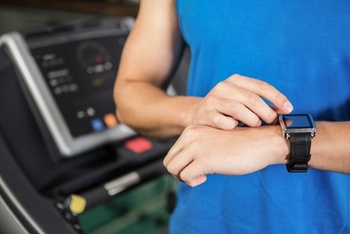Tracking the calories you burn from your workouts could sabotage your fat loss? What? Aren’t you supposed to do that? Isn’t it a good idea to use fitness trackers to monitor your calorie burn? Don’t you want to know how many calories your 45 minutes on the treadmill burned off? Well, maybe… and fitness trackers can be helpful in many other ways, but if you try to use information about exercise calories burned to make adjustments to the amount of calories you eat, you are in grave danger of committing a massive fat loss mistake…
I recently received two separate questions about workout calories burned:

1. How do I accurately calculate my exercise calories burned?
2. Do you think calories burned readouts from cardio machines or fitness trackers are accurate and worth using?
These questions get asked all the time, and while they seem like fair and innocent inquiries, I usually assume there is a particular intention behind them:
Most people want to know how to figure out the calories they are burning at every workout so they can reconcile calories in versus calories out, adjust their food intake, and try to make sure they have a calorie deficit every day.
Most people also figure if they burn more on one day, they’ll eat more, and if they burn less on another day they’ll eat less. Often, they rationalize that if a single workout burns a lot more than usual, they have room to add in a treat meal or extra tasty snack.
This seems perfectly logical, and in some ways, it is; you want a calorie deficit for fat loss and energy balance for maintenance, and if you burn 3000 calories a day you can eat a lot more than someone who only burns 2000 calories per day and still lose weight..
Yet most people are surprised or even shocked when I tell them you don’t need to know how many calories each individual workout or activity burns.
Here’s why:
Your Exercise Calories Burned Were Already Counted!
When you initially set up your nutrition plan, the first thing you do is use a calorie calculator formula to estimate your basal metabolic rate (BMR). That’s how many calories your body burns just to cover basic body functions.
The second thing you do is estimate your activity level. Your activity factor includes formal workouts as well as work, walking and all other daily activity. This is where your exercise calories burned are already counted (in advance – when you do your macro and meal plan set up, you’re estimating your anticipated daily average).
When you multiply your BMR by your activity factor, what you have then is your total daily energy expenditure (TDEE) also known as your maintenance level. That’s all the calories you burn in a day.
You can do these calculations by using scientific equations such as the Katch-McArdle or the Harris-Benedict calorie formula, which are featured in the Burn the Fat, Feed the Muscle book as well as readily available online including at Burn the Fat Inner Circle.
If you want to lose fat, the third step for meal plan set up is you simply drop calories a little below that, maybe 20 or 25% under maintenance. That is where your weight loss comes from.
Here’s the key point: Since you already counted all your exercise calories burned, counting workout calories again would be not only be redundant, if you ate more, you’d be eating into your deficit.
Eating Back Calories Burned = Diet Sabotage
One of the biggest ways people sabotage themselves is by watching how many calories they burn in individual workouts, then eating back what they just burned – an error known as “compensation.” This is compounded by a behavior that psychologists have documented, called “moral licensing,” where people do something good (exercise), and then feel like they deserve to do something bad (eat junk).
Suppose you look at the treadmill readout and it says you burned 500 calories. It’s tempting, almost a natural reaction, to think you should add that on top of your daily burn and eat 500 more calories. That’s not how to manage calories for fat loss – that’s actually the cause of fat loss plateaus – it’s a mistake that wipes out your calorie deficit.
What you should do instead is start your program by creating a personal daily meal plan based on your calorie deficit target and your desired macros, and then follow that meal plan every day, all week long. Some people vary (cycle) their calories intentionally for various reasons, but don’t add extra calories on top of your pre-calculated meal plan based on workout calories burned. In fact, don’t even focus on how many calories individual workouts burn, focus on the number of calories you’re supposed to eat, which you calculated in advance.
To decide whether to eat more or less, measure your results every week (weight, body composition, measurements, visual assessment) and if you achieved the fat loss you wanted, don’t change a thing. If your fat loss stalled, then decrease your calories. If you lose too much weight or too much lean body mass, increase your calories.
This is the Burn the Fat, Feed the Muscle feedback loop system – set up a meal plan with a calorie deficit, follow it all week, measure your results and then decide if you need to make changes.
Some Good Reasons To Track Calories Burned From Workouts
If you want to, you can still use electronics to estimate workout calories burned for other reasons which could be helpful:
1. Accountability and motivation. Smartwatches or trackers that you wear all day long are especially good for making you conscious of how much you’re moving or burning outside the gym, and keeping you moving instead of lounging around.
2. As an educational tool. Learning how many calories different types of exercise burn for a given time investment can be good to know, especially for busy people who want to get the most results in the least time.
3. Record keeping. You could record calories burned in your training lo, if you want to track cardio progression.
In addition, fitness electronics give you all kinds of other non-calorie related information that might make them worthwhile, so I’m not knocking any fitness trackers in any way – I like them – including step trackers.
If you want to track exercise calories burned for these or other reasons, you could use cardio machine readouts, wearable fitness trackers or online calculators.
Calories Burned Readouts On Cardio Machines… Accurate?
The other big question is whether the calories burned readouts on cardio machines are even accurate. If the machine asks you to input personal data such as body weight and you don’t “cheat” by leaning or hanging on the handles or side rails, it can often be a reasonable estimate. However, it’s still only an estimate.
Today most people use wrist-worn fitness trackers (smartwatches). These electronics may track steps and estimate calories burned from step count, or they may monitor heart rate during individual exercise bouts, and estimate calories for a single workout burned that way. Like cardio machines, fitness trackers can give you a ballpark estimate, especially if your weight is accounted for, but again, it’s still just an estimate.
Regardless of what type of electronics you use, I don’t recommend them for adjusting your food intake day to day, even though many fitness apps do just that (“You have 750 remaining calories for the day” and so on). Follow the meal plan or the calorie and macro plan you set up to begin with consistently. Then adjust your meal plan based on your results each week, not your calorie burn each workout.
It can also help change the way you look at things if you think in terms of weekly calorie deficits, not just daily deficits, and remember that daily numbers will fluctuate as your activity fluctuates, but it can all average out to a deficit at the end of the week.
Parting Advice
To do the initial set up of your nutrition plan, all you need is a goal, a calorie calculator and macro guidelines. To make diet adjustments, you don’t need to know the calories burned from individual workouts each day, just measure your body composition results every week or two.
Then, simply adjust your calories based on your weekly results. If you lost fat, don’t change a thing. If you didn’t lose fat, you weren’t in a deficit and you must create a deficit for the week ahead, or you’ll only stay stuck. Take your pick: fewer calories in or more calories out. Then rinse and repeat!

Tom Venuto is a lifetime natural (steroid-free) bodybuilder, fitness writer and author of Burn The Fat, Feed The Muscle: Fat Burning Secrets of Bodybuilders and Fitness Models and the national bestseller, The Body Fat Solution, which was an Oprah Magazine and Men’s Fitness Magazine pick. Tom has appeared in The New York Times, Wall Street Journal, Huffington Post, Oprah Magazine, Muscle and Fitness Magazine, Ironman Magazine and Men’s Fitness Magazine, as well as on dozens of radio shows including Sirius Satellite Radio, ESPN-1250 and WCBS. Tom is also the founder and CEO of Burn The Fat Inner Circle – a fitness support community for inspiration and transformation






OMG…this is one of my biggest pet peeves about the calorie tracking devices….Other that stroking your ego…they are as accurate as a 2 dollar watch. And eating your exercise calories back is pure sabotage. There was a time that I made this mistake. And daily my calorie tracking app used to congratulate me on staying in a 500 cal a day deficit….only instead of loosing a pound a week I gained a pound a week. Keep in mind that also if you want to count calories….you need to eat very simple meals, because there can a ton of inaccuracy in recipes unless you do the work your self. Simply using calories for Meatloaf, Generic, 1 serving is a guaranteed recipe for diet disaster.
Yep, that could be a whole other post about simple meals… or, the effect of food variety and high food choice on overeating….
Re: calorie estimates inaccuracy… I’m sure some devices are way off… but… at least they’re better than human estimates, lol. Humans are well-proven through scientific research to be absolutely horrible at guessing both number of calories burned and number of calories consumed, over-estimating the former and under-estimating the latter
Mr. Venuto, I admire your work, Burn the Fat Feed the Muscle, makes my top 10 list, and I like to read. So, yes I am a big fan. It was executed perfectly, I want to invest in myself. This is new path for me and I ask for your help.
I will put in the work. All I ask is for you to show me the way. I offer my friendship, and I am a man of my word. I will back in writing; because it is to difficult to sort through the herd.
Sincerely;
Anthony A. Corrente – age 44, North Providence, RI